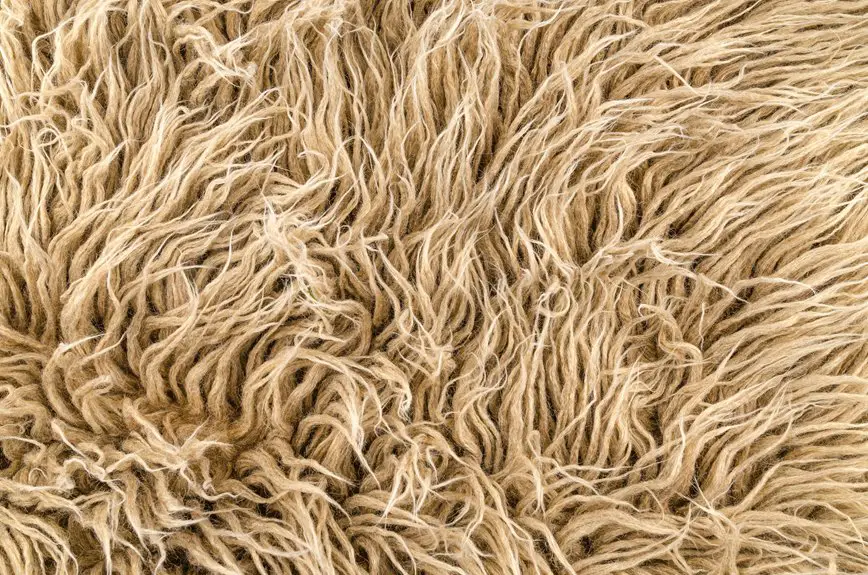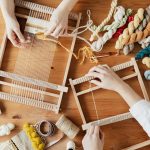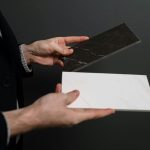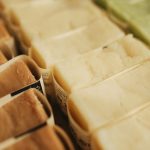Yes, felt is a nonwoven fabric because it’s made by matting, condensing, and pressing fibers together instead of weaving or knitting them. You’ll find it typically uses animal fibers like wool, bonded through heat and pressure, giving it a dense, durable texture without fraying edges. Felt’s unique production process sets it apart from other nonwovens that may rely on chemical or mechanical bonding. If you want to understand felt’s origins, uses, and how it compares to similar fabrics, there’s much to explore.
Table of Contents
Key Takeaways
- Felt is a nonwoven fabric formed by matting, condensing, and pressing fibers together without weaving or knitting.
- Unlike woven textiles, felt relies on heat, moisture, and pressure to interlock fibers, typically using animal wool or synthetics.
- Felt’s dense, durable structure results from fiber entanglement rather than chemical or mechanical bonding used in other nonwovens.
- Its unique texture is thick, pliable, and does not fray at edges, distinguishing it from woven or knitted fabrics.
- Felt’s classification as a nonwoven fabric is definitive due to its production method and fiber bonding process.
Understanding Nonwoven Fabrics: Key Characteristics
Although you mightn’t realize it, nonwoven fabrics differ considerably from woven or knitted materials. Unlike those, nonwovens aren’t created by interlacing threads or yarns. Instead, they’re made by bonding or felting fibers together using chemical, mechanical, heat, or solvent treatments.
This process gives nonwoven fabrics unique properties like uniform strength, water resistance, and quick production times. You’ll find them in products ranging from medical masks to geotextiles.
Because they don’t rely on weaving or knitting, nonwovens can be engineered to serve specific needs, such as enhanced filtration or cushioning. When you handle nonwoven fabrics, you’ll notice their texture is often denser or more felt-like, setting them apart from traditional textiles and opening up a wide range of applications.
The History and Origins of Felt
You might be surprised to learn that felt is one of the oldest textiles, created by ancient cultures thousands of years ago.
People across different regions have used felt for clothing, shelter, and even art.
Let’s explore how this versatile fabric started and why it’s been so important throughout history.
Ancient Felt Making
Since felt is one of the oldest known textiles, its origins date back thousands of years to ancient civilizations.
You’d be fascinated to learn that early humans discovered felt by accident, noticing how animal hair mats together when exposed to moisture, heat, and pressure. This simple yet effective technique allowed them to create durable fabrics without weaving or knitting.
When you explore ancient felt making, you’ll find:
- Evidence of felt artifacts from Central Asia dating back to 6500 BCE
- Use of wet felting methods involving soap, water, and agitation
- Nomadic cultures relying on felt for clothing and shelter due to its insulation
- Early felting tools made from natural materials to aid in the process
This hands-on craft shaped textile history long before modern fabric technology emerged.
Cultural Felt Uses
When you explore various cultures, you’ll see felt has played a significant role beyond just fabric—it’s deeply woven into traditions, rituals, and daily life.
In Central Asia, for example, felt forms the walls of yurts, providing insulation and portability for nomadic lifestyles. You’ll find felt used in clothing and ceremonial items among Mongolian and Kyrgyz peoples, symbolizing protection and heritage.
In Turkey and parts of Eastern Europe, felt serves as prayer mats and ritual objects, linking spirituality to everyday materials.
Even in Scandinavia, felt appears in traditional footwear and crafts, showcasing its versatility.
How Felt Is Manufactured
Crafting felt involves matting, condensing, and pressing fibers together without weaving or knitting. When you make felt, you start by arranging fibers like wool in layers.
Then, you apply moisture, heat, and pressure to bond these fibers tightly. This process creates a dense, durable fabric.
Here’s what you need to know about felt manufacturing:
- Fibers are typically animal-based, like wool, but can include synthetic options.
- The fibers’ scales interlock during agitation and heat, providing strength.
- Wet felting uses water and soap, while needle felting employs barbed needles to tangle fibers.
- The thickness and density depend on the amount of pressure and time spent in the felting process.
Comparing Felt to Other Nonwoven Materials
You’ll notice that felt and other nonwoven materials use different manufacturing methods, which affects their final structure.
While felt relies on matting fibers together through heat and pressure, other nonwovens might use bonding or entangling techniques.
Understanding these processes helps you see how their textures and strengths vary.
Manufacturing Methods Overview
Although felt shares some similarities with other nonwoven fabrics, its manufacturing process stands apart in key ways. When you look at how felt is made, you’ll notice it relies heavily on matting, condensing, and pressing fibers together without weaving or knitting. This contrasts with other nonwovens that often use chemical, mechanical, or thermal bonding.
Here’s how felt’s method compares:
- Felt uses heat, moisture, and pressure to entangle fibers naturally.
- Other nonwovens may bond fibers using adhesives or ultrasonic welding.
- Felt production often involves animal fibers like wool, while many nonwovens use synthetic fibers.
- The process of felting creates a dense, durable fabric without additional binders.
Understanding these differences helps you appreciate why felt’s texture and properties stand out among nonwoven materials.
Structural Differences Explained
When you examine felt alongside other nonwoven materials, the structural differences become clear in how their fibers interact and bond.
Felt’s fibers are tightly matted and compressed through heat, moisture, and pressure, creating a dense, cohesive fabric without weaving or knitting. In contrast, other nonwovens often rely on mechanical entanglement, adhesives, or chemical bonding to hold fibers together.
For example, spunbond nonwovens use thermoplastic fibers melted and pressed to form a web, while needle-punched fabrics mechanically tangle fibers with barbed needles.
Felt’s unique structure gives it a firm, durable texture, whereas other nonwovens can vary widely in strength and flexibility depending on their bonding techniques.
Understanding these differences helps you appreciate felt’s distinct place among nonwoven fabrics.
The Role of Fibers in Felt Production
Fibers form the foundation of felt production, determining its texture, strength, and durability. When you choose fibers, you directly impact how the felt behaves and feels.
Natural fibers like wool have scales that lock together easily, making the felting process more efficient. Synthetic fibers, on the other hand, might require blending or additional treatment to achieve the same effect. Understanding fiber characteristics helps you tailor the felt for specific uses.
Consider these fiber factors in felt production:
- Fiber length influences the felt’s density and smoothness.
- Fiber type affects water resistance and insulation properties.
- The crimp or waviness of fibers enhances interlocking during felting.
- Fiber purity impacts the felt’s uniformity and strength.
Common Applications of Felt in Various Industries
The qualities of the fibers you choose directly shape how felt performs across different applications. When you work with felt, you’ll find it’s widely used in industries like automotive for soundproofing, fashion for hats and accessories, and crafts for decorative projects. Felt’s dense, soft texture makes it perfect for insulation and padding too. You can even use it in musical instruments and industrial gaskets because it’s durable yet flexible.
| Industry | Common Use | Key Benefit |
|---|---|---|
| Automotive | Sound insulation | Noise reduction |
| Fashion | Hats, accessories | Softness, flexibility |
| Crafts | Decorations | Easy to shape |
| Industrial | Gaskets, seals | Durability |
| Musical | Instrument pads | Vibration damping |
This versatility shows felt’s unique role beyond traditional fabrics.
Advantages and Disadvantages of Felt as a Fabric
Felt offers a unique blend of benefits and drawbacks that you should consider before using it in your projects.
Felt combines distinct advantages and disadvantages worth evaluating for your creative projects.
It’s a versatile material, but it’s not perfect for every application. You’ll appreciate felt’s durability and insulating properties, but you should also be aware of its limitations.
- Advantages:
- Excellent insulation against heat and sound.
- Resistant to fraying and unraveling.
- Easy to cut and shape without finishing edges.
- Offers a soft, cushioned texture.
- Disadvantages:
- Prone to water absorption, which can weaken it.
- Limited stretch and flexibility compared to woven fabrics.
- Can pill or shed fibers over time.
- Not as breathable, which might cause discomfort in clothing.
Weigh these factors to decide if felt suits your needs.
How Nonwoven Fabrics Differ From Woven and Knitted Fabrics
Although you mightn’t always notice it, fabrics come from different construction methods that affect their texture, strength, and flexibility.
Nonwoven fabrics, like felt, are made by bonding fibers together using heat, pressure, or adhesives without weaving or knitting. This process gives nonwovens a dense, uniform texture but less stretch and drape compared to woven or knitted fabrics.
Woven fabrics come from interlacing yarns at right angles, creating a strong, stable material with little elasticity.
Knitted fabrics use loops of yarn, which gives them excellent stretch and flexibility.
When you compare the three, nonwovens feel stiffer and less stretchy, woven fabrics are durable but less flexible, and knits offer the most comfort and give.
Understanding these differences helps you choose the right fabric for your needs.
Innovations and Modern Uses of Felt
Innovations in materials and techniques have transformed felt from a traditional fabric into a versatile choice for modern applications.
You’ll find felt used beyond crafts—its durability and flexibility make it ideal for various industries. New synthetic fibers and eco-friendly blends improve its strength and sustainability, while advanced manufacturing allows precise thickness control and custom shapes.
You can explore felt in:
- Acoustic panels for noise reduction in offices and studios
- High-performance insulation in automotive and aerospace sectors
- Fashion accessories combining texture and durability
- Smart textiles embedded with sensors for wearable tech
These innovations prove felt’s adaptability, making it a smart, functional material you can rely on in cutting-edge designs and everyday solutions.
Identifying Felt in Everyday Products
You’ve probably touched felt without even realizing it—it’s in common household items like coasters, slippers, and craft supplies.
You can spot felt by its dense, slightly fuzzy texture that doesn’t fray at the edges.
Next time you’re around the house, try identifying felt by feeling for its unique softness and firmness.
Common Felt Applications
Felt appears in many everyday items you mightn’t immediately recognize. When you handle or see these products, you’re often encountering felt’s unique properties, like cushioning and insulation.
You’ll find felt in both practical and decorative uses, making it incredibly versatile.
Here are some common felt applications you’ll likely encounter:
- Furniture pads that protect floors from scratches
- Craft projects like ornaments and toys
- Hat making, especially classic styles like fedoras
- Musical instrument components, such as piano hammers
Recognizing Felt Texture
A soft, dense texture often signals the presence of felt in everyday items. When you touch felt, you’ll notice it feels thick yet pliable, with a slightly fuzzy surface.
Unlike woven fabrics, felt doesn’t have visible threads or a grid pattern. Instead, it’s made by compressing fibers together, giving it a uniform, matte look.
If you press your finger into felt, it will resist stretching and keeps its shape well. You might also detect a muted sound when rubbing felt, unlike the rustle of woven cloth.
Felt in Household Items
Although it mightn’t be immediately obvious, many household items contain felt due to its durability and unique texture.
When you look around your home, you’ll find felt used for both practical and decorative purposes. Its ability to absorb sound and protect surfaces makes it a popular choice in everyday products. You can easily identify felt in common items by checking for that dense, slightly fuzzy feel without any visible weaving.
Here are some household items where felt is often found:
- Furniture pads to prevent floor scratches
- Coasters that absorb moisture
- Decorative wall panels for soundproofing
- Drawer liners to protect delicate items
Next time you notice these items, you’ll recognize felt’s subtle but essential role in your home.
Frequently Asked Questions
Can Felt Be Recycled or Is It Biodegradable?
Felt’s fate fluctuates: if it’s fiber-friendly, you can recycle it responsibly. Otherwise, it biodegrades beautifully, breaking back into the biosphere. You should check its material makeup to manage it mindfully and minimize environmental impact.
What Types of Fibers Are Best for Making Felt at Home?
You’ll want to pick wool fibers like merino or alpaca for felting at home since they easily mat together. Avoid synthetic fibers—they don’t felt well. Natural fibers give you the best texture and durability.
How Does Humidity Affect the Quality of Felt?
When humidity sneaks into your workspace like a silent fog, it softens fibers, making your felt less firm. You’ll notice it’s harder to achieve that crisp texture, so keep moisture low to craft quality felt.
Is Felt Safe for Use in Baby Products or Toys?
You can use felt in baby products or toys safely if it’s made from non-toxic, hypoallergenic materials and properly cleaned. Always check for certifications and avoid small parts that could pose choking hazards.
Can Felt Be Dyed Easily With Natural Dyes?
Dyeing delicate felt delights DIYers! You can certainly soak your soft, spongy fabric in natural dyes, but remember, colors might vary and require careful crafting to capture consistent, colorful, and charming results in your creative projects.
- The Use of Nonwovens in Construction and Civil Engineering - July 11, 2025
- The Use of Nonwovens in Construction and Civil Engineering - July 11, 2025
- The Use of Nonwovens in Construction and Civil Engineering - July 11, 2025







